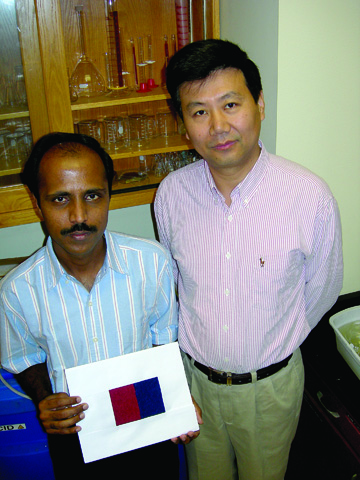| |
|
|

from the issue of October 12, 2006
|

| |
|
|
| |
Researchers eye ag products for fiber options

Fashions from the Field

UNIVERSITY COMMUNICATIONS
Yiqi Yang sees opportunity in harvest leftovers.

| | 
 
| | | FIBER RESEARCHERS – Narenda Reddy, research assistant, holds a cloth sample made from rice straw fibers. Reddy and Yiqi Yang, professor of textiles, clothing and design, research agricultural by-products for textile production. Photo by Troy Fedderson/University Communications.

|
First it was corn husks converted to cloth two years ago. Now, it's rice straw with a possibility of chicken feathers providing similar sources for textiles production.

Yang, professor of textiles, clothing and design, presented papers on the rice straw and chicken feather research on Sept. 11 and 12 at the 232nd national meeting of the American Chemical Society. Narenda Reddy, a research assistant and doctoral candidate, collaborated in both studies.

"We hope that this research will stimulate interest in using agricultural byproducts as textiles fibers," Yang said. "That would add value to agricultural crops and make the fiber industry more sustainable."

Corn husks were an obvious first choice for a professor based in Nebraska. However, Yang's Chinese heritage and global demand for rice provided a new direction for the research.

"Rice is the biggest crop in the world," Yang said. "It has to be grown. And, about 580 million tons of rice straw are wasted every year. But, it does not need to be wasted. It can be used."

Rice straw consists of the stems of the rice plant that are left over after rice grains are harvested. Like cotton and linen, rice straw is composed mostly of cellulose.

Yang and Reddy extracted fibers from the straw using a combination of chemicals and enzymes. The process is under patent review.

Properties of the fibers indicate that they are capable of being spun into fabrics using common textile machinery. Yang said rice fiber fabric would be similar to cotton or linen.

"It is a little bit stiffer than cotton, but not bad at all," Yang said. "It is like linen. It can be ironed. And, we will be doing wash tests next."

The rice fibers are the most developed of the two fabric concepts presented at the conference.

Yang said the chicken feathers are composed mostly of keratin, the same type of protein in wool. The researchers are particularly interested in the barbs and barbules - thin, filamentous networks that form the fluffy parts of the feather. Those structures have sturdy honeycomb architecture with tiny air pockets that make the filaments lightweight and resilient. Yang said the feather properties offer the potential for fabrics that offer lighter weight, shock absorption and superior insulation.

"The chicken feathers have some good, unique properties - especially if you want to keep warm in winter weather in Nebraska," Yang said. "But, for right now, all we have done is identify the characteristics of the fiber property."

Chicken feathers and rice straw also could become "green" fabrics used in carpets, automobiles, building materials and other everyday applications.

Yang and Reddy will continue to develop the feather process. They are also researching similar properties in other agricultural byproducts.

While adding value to an ag-based product, the process could also curb costs in the textile industry.

"Fifty percent of all fibers in the industry are made from petroleum," Yang said. "That is not a sustainable product. And, if oil prices rise, then what happens?"

While agricultural byproducts are readily available at low costs, Yang said the research has not been adopted by the textile industry. He said industry trends would determine the acceptance of corn husk, rice straw or chicken feather fabrics.

"The industry is driven by designers," Yang said. "We know these types of textiles have a market. But, we need to wait and let the designers introduce them, then it will be something the consumers accept."

If an investor is identified, Yang said production could proceed quickly.

"If an investor was identified and we received money tomorrow, we could get a product out in two years," Yang said. "We are ready."


Rice Research
Viable supply

• Rice is a staple source of nutrition for over half of the world's population, with over 400 million tons grown annually.

• The United States consistently ranks in the top 5 rice exporting countries, supplying about 14 percent of the rice that enters world trade.

•The major rice producing states are Arkansas, California, Louisiana, Texas, Mississippi and Missouri.

• About 580 million tons of rice straw goes unused annually, making it readily available at low costs. Yang and Reddy use rice straw from California for their research. Yang said the straw is provided free, with shipping as the only expense.

Straw to cloth

Using a combination of chemicals and enzymes, UNL researcher Yiqi Yang and Narenda Reddy convert rice straw (top left) into cotton-like fibers (top right). The fibers can be used in textile production. The fabric sample shown was created by Yang and Reddy. It is a 50-50 blend of rice and cotton fibers. Yang said rice-fiber fabric would be similar to cotton and linen.
GO TO: ISSUE OF OCTOBER 12
NEWS HEADLINES FOR OCTOBER 12
Fashions from the Field
Diversity plan ready for review
J.D. Edwards pupils to mix with national business execs
Lecture to link genes, politics and behavior
Specialists featured in Weather Channel, HBO shows
Statewide decline
UNL joins higher ed teaching assessment project
UNL science team reports to Antarctica
732596S36288X
|
|
|
|
|
|
|
|